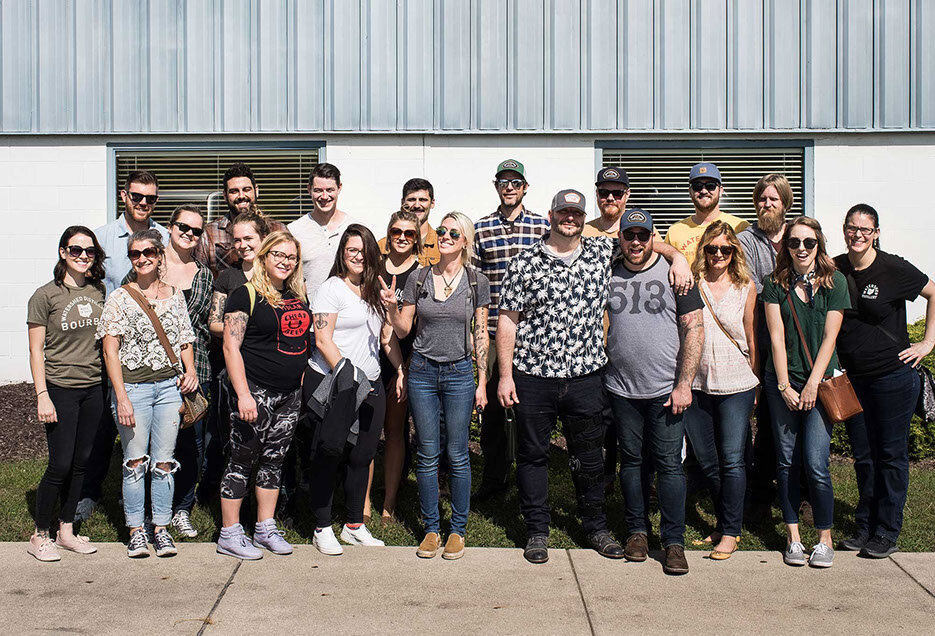How It’s Made: Watershed Barrels
Take a trip to Speyside Cooperage in Jackson, Ohio
Recently we got a chance bring the whole team down to Speyside cooperage where our barrels are made. We’re always excited when we get a chance to meet people who are passionate about their work, but it’s especially exciting to meet the people who have such a big impact on the work we do here. We’re also excited that we get to share a bit of that here with you on the blog so you can get an inside look at a process few people ever get to see.
Joe (right) and Donald (left) Cullman. Black Walnut aficionados and just overall kind people.
First, let’s talk about how we use barrels and why they’re important. All bourbon requires aging in a brand new charred american oak barrel. In our warehouse right now, we’ve got around 1000 barrels laid down and that number is growing weekly. Those barrels spend years in our warehouse through cold winters and hot summers aging our bourbon, and other spirits. The warehouse is intentionally left open to the elements so that as the wood expands and contracts in the heat and the cold, the spirit flows in and out of the wood extracting sugars, and vanilla flavors, and all the other great stuff barrels have to offer.
Around 60-70% of the flavor in bourbon comes from the barrel, and each barrel contains about 53 gallons, or around 250 bottles worth of bourbon. So it’s important that we get well built barrels, with consistent char levels, and absolutely no leaks or flaws whatsoever. Oh, and we need a lot of them. Remember what we said about bourbon requiring brand new charred american oak barrels? The key here is that word new; we can’t re-use barrels for bourbon. We can use those barrels for things like our apple brandy, or bourbon barrel gin, or pass them off to some of our favorite breweries to age their beers, but for our bourbon (which we make more of than any other aged spirit) we have to have a whole new set of barrels for each and every batch. That adds up to a lot of barrels, and that’s where our friends at Speyside come in.
We take a certain amount of pride in sourcing things as close to home as possible, but as we grow, it becomes harder and harder to scale those local sources with us. When people talk about sourcing things locally, a lot of people think about small mom and pop shops with a few employees, and that’s certainly not what Speyside is, Speyside is a multinational corporation with thousands of employees around the world. But for us, the idea of sourcing things as close to home as possible is not about sticking it to the man, and refusing to work with large businesses, the idea is that we get to work with our neighbors, people we can see and talk to in person. We want to be able to see an impact in our local economy, and when Speyside set up shop in a shuttered cabinet factory in Jackson, Ohio, an area where jobs can be hard to come by, there was certainly a big impact.
Speyside also bought two sawmills in Waverly, Ohio so that they could source, and process the oak for their barrels all within a couple hundred miles of the cooperage. For them it may have just been a cost saving measure, but for us as customers, it means that we get to play a small part in providing even more jobs in our local economy. It also means that everything down to the white oak that makes up our barrels comes from as close to home as we can manage.
When you step into Speyside Cooperage, the first thing you notice is just how massive it is. Hundreds of thousands of square feet of factory floor with the constant hum of equipment reverberating throughout the cavernous space, punctuated by the occasional holler of an employee from across the room. In any operation of this size, there’s bound to be some automation, but barrel rasing is still mostly done by hand. Each barrel is touched by at least 14 people, and while there are conveyor belts moving the barrels from station to station, each one of those stations is manned by one or more people doing complicated work with a level of speed, efficiency, and precision that seems impossible. Every barrel is made up of staves pieced together, not by computers, but by people trying to figure out the jigsaw puzzle that ends up with a fully sealed watertight (or whiskey-tight) barrel. There are no nails, or screws holding them together, just wood, steel hoops, and a barrel raiser who knows what they’re doing.
After they’ve been roughly pieced together, it’s time for the char. Unfortunately we weren’t able to photograph this step but if you can imagine flames shooting into a barrel for a minute or so, then you’ll have a pretty good idea. There are different levels of char to a barrel, and that is determined by how long a flame has been held to the inside. At Watershed, we use a Char 5 barrel to impart the most flavor possible on our bourbon. Charring barrels also acts as a natural filter for some sulfur compounds, similar to charcoal filtration systems.









